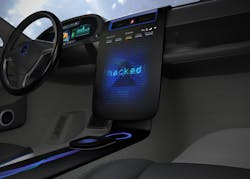Computer technology, telematics, smarter vehicles, the Internet and The Cloud are helping to make driving safer, as well as more enjoyable. All this technology is helping to also improve vehicle performance, optimize route planning and navigation, monitor driver hours and performance, track and report on internal systems and vehicle usage, aid in regulatory compliance, enhance diagnostic capabilities, provide forward collision warning and automatic braking, enhance communication, information and entertainment systems and the list goes on and on.
Add to this the evolution of Intelligent Transportation Systems (ITS). These utilize synergistic technologies and systems engineering concepts to develop and improve transportation systems.
Two areas of research and development are the realization of connected vehicle implementation – wherein vehicles are in two-way communication with other vehicles, the transportation infrastructure and various devices – and the advancement of automation.
The objective of ITS is to enable society to move more safely and efficiently, plus reduce the environmental impact.
As technology continues to advance, vehicles of all kinds will get smarter and more connected.
Ponder this. Research by technology market intelligence firm ABI Research predicts that more than 60 percent of new cars worldwide are expected to have connected capabilities by next year.
Fears
This is all well and good, but it raises some concerns. One is that vehicles are becoming more reliant on advanced-interconnected computer systems. With technology creating more automatic processes that reduce issues caused by driver error, technicians become more liable for fixing these complex systems.
Another is safety concerns, especially with distracted driving due to in-vehicle electronic devices.
There is also the trepidation over privacy, say officials at Zurich Insurance Group (www.zurich.com), a leading multi-line insurer. They note that while consumer privacy is regulated to varying degrees, when it comes to banking transactions, medical records, phone and Internet use, etc., data generated by vehicles, for the most part, is not. “As a result, consumers have little control over who can see their data and how it can be used,” they say.
Information produced by a vehicle and transmitted over the Internet can be intercepted, they add. “Ultimately, it ends up on servers, making it a potential target for law enforcement officials, trial lawyers and hackers. That information also may be sold or otherwise used for purposes never contemplated by the vehicle owner.
“The concerns multiply with the number of connected systems in a vehicle.”
Unauthorized Use
If all that weren’t enough cause for uneasiness, because vehicles are increasingly relying on computer technology for more and more things, the susceptibility to being hacked is increasing.
In 2010, security researchers took over all of a car’s vital systems by plugging a device into its OBD-II port. Since then, there have been numerous instances where security researchers have remotely taken control of a vehicle by breaking into its multiple computers that are coupled together through a maze of networks by compromising an array of “security holes.”
The vulnerability of vehicles to hacking is sufficiently troublesome that the Defense Advanced Research Projects Agency, a research arm of the Pentagon, is financing research into security weaknesses, note Zurich officials.
The Threat Evolves
At present, there are very few cybercriminals who are skilled enough to hijack a vehicle using only a laptop, say officials with security firm Trend Micro. However, as automobiles become more thoroughly wired into the Internet of Things, it will become “increasingly simple for criminals to wreak havoc on the roadways.”
Vehicle makers have taken steps to secure onboard networks, but the threat is continuously evolving.
It will be most interesting to see how all this plays out.
I welcome your thoughts and ideas.
About the Author

